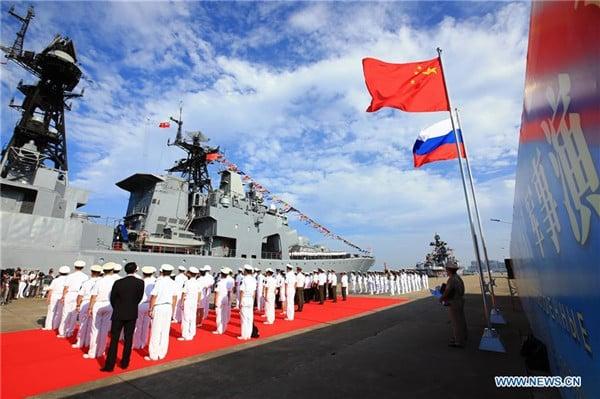In a growing diplomatic rift between Beijing and Canberra,China has accused Australia of “hyping” its recent naval drills,intensifying concerns over regional security and international maritime tensions. The accusations follow Australia’s critical stance regarding the exercises, which are seen by some as a exhibition of military might amid rising geopolitical rivalry. this development comes at a time when both nations are navigating complex relationships with neighboring countries, and also engaging in broader discussions on trade, security, and regional stability. As tensions mount, analysts are closely monitoring the implications of these naval maneuvers and the rhetoric surrounding them, highlighting the delicate balance of power in the Indo-Pacific region.
Chinas Response to Australian Criticism of Naval Drills

In response to growing concerns from Australia regarding its recent naval exercises,China has dismissed these apprehensions as an attempt to exaggerate the situation. Chinese officials argue that such drills are a standard practice aimed at enhancing maritime security and bolstering defensive capabilities.they emphasized that Australia’s portrayal of these maneuvers creates needless tension in the region, asserting that the exercises are conducted in accordance with international law and do not threaten any nation.
Furthermore, China accused Australia of playing a leading role in escalating regional tensions through its military alliances and rhetoric. The Chinese government pointed out that rather of supporting peace and stability, Australia’s actions contribute to a narrative of confrontation. In light of this, Beijing urged canberra to adopt a more balanced approach, lowering rhetoric and focusing on dialog and cooperation to ensure mutual understanding and regional harmony. Key points of contention include:
- Exaggerated Concerns: claims that China’s drills are a potential threat.
- Standard Practice: Emphasis on the normalcy of naval exercises.
- Regional Stability: Call for balanced military strategies and dialogue.
Analysis of the Strategic Implications of Chinas Naval Exercises

The recent naval exercises conducted by China have elicited varied reactions on the global stage, particularly from regional players like Australia. As Australia has accused China of raising tensions, the implications of these drills extend beyond mere show of force. The drills reflect a strategic enhancement of China’s naval capabilities, which may include:
- Increased Regional Influence: Demonstrating power in contested waters, particularly in the South China Sea.
- Military Readiness: Enhancing operational capabilities to respond swiftly to potential maritime threats.
- Diplomatic Signals: Conveying resolve to both neighboring countries and international allies regarding China’s interests.
Furthermore, these exercises can reshape the maritime security landscape in the Indo-Pacific region. As countries reassess their defense postures, the implications might include a shift towards:
- Greater Military Alliances: Strengthening partnerships among nations wary of China’s growing assertiveness.
- Increased Defense Spending: Countries may ramp up investment in their naval and broader military capabilities.
- Heightened Surveillance: Enhanced intelligence-sharing and surveillance activities among allied nations.
| Aspect | Implication |
|---|---|
| Regional Tensions | Potential conflicts or skirmishes |
| Military Balance | Shift towards collective security measures |
| International Trade | Impact on global shipping routes |
Recommendations for Diplomatic Engagement Between China and Australia

To foster better diplomatic relations between China and Australia,it is crucial for both nations to adopt a multifaceted approach that emphasizes dialogue,transparency,and mutual respect. Engagement initiatives can be promoted through:
- Regular Bilateral Meetings: Establishing routine high-level dialogues to address key issues and concerns.
- Cultural Exchanges: Promoting programs that enhance understanding of each other’s histories, values, and traditions.
- Joint Economic Projects: Collaborating on business ventures in sectors of common interest, such as renewable energy and technology.
- Strategic Defense Dialogues: Creating platforms for discussing defense strategies to reduce tensions in maritime regions.
Moreover, communication channels must be strengthened to ensure that minor disagreements do not escalate into larger conflicts. Both countries should consider initiatives such as a joint fact-finding commission to carefully assess and communicate the implications of military exercises. This could be supplemented by the establishment of a China-Australia Advisory Panel, aimed at providing recommendations based on expert analysis. The table below summarizes proposed areas for collaboration:
| Area | Proposal |
|---|---|
| Trade | Establish complete trade agreements with mutual benefits. |
| Education | enhance student exchange programs to cultivate mutual understanding. |
| Habitat | Joint efforts in climate change initiatives and conservation projects. |
Assessing the Impact of Naval Tensions on regional Security Dynamics

the recent tensions stemming from China’s naval drills have sparked significant debate regarding their implications for regional security. With australia accusing China of aggressive posturing, the diplomatic landscape becomes increasingly fraught.Analysts suggest that such claims from Australia could be viewed as a strategy to bolster alliances within the Asia-Pacific region, thereby seeking to counterbalance China’s growing maritime capabilities.In a landscape where military exercises frequently enough serve as indicators of national intent, the rhetoric surrounding these drills is highly likely to intensify, influencing how neighboring countries perceive and respond to perceived threats.
Consequently, the ripple effects of these naval tensions could alter existing security dynamics across the region. Observers point to several key areas of concern:
- Alliances Strengthening: Countries might strengthen defense pacts to present a united front against perceived aggression.
- Military Preparedness: Increased military spending and preparedness among countries wary of China’s influence.
- Diplomatic Engagements: Heightened diplomatic discussions and forums to navigate and de-escalate tensions.
As regional players navigate these choppy waters,the balance of power may shift,prompting a re-evaluation of strategies and partnerships that define security in the Asia-Pacific region.
Closing Remarks
the recent escalation in rhetoric between China and Australia surrounding naval drills highlights the ongoing tensions between the two nations. With Beijing accusing Canberra of sensationalizing its military maneuvers, the situation underscores the delicate balance of power in the Asia-Pacific region.As both countries navigate their complex relationship marked by trade, security concerns, and regional influence, analysts suggest that open dialogue and diplomacy will be essential to mitigating the risks of miscommunication and conflict. The international community, closely monitoring these developments, will be watching to see how this narrative unfolds and what it signifies for future relations in a rapidly changing geopolitical landscape.




